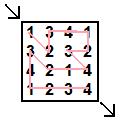AKARI RULES ~
The black squares with numbers in them represent how many light bulbs (represented by a circle) it is adjacent to. Every square in the grid must be "lit up" by light bulbs. A light bulb shines on every square vertically and horizontally until it hits a black square. No light bulb can be lit up by another light bulb. Not every light bulb on the grid will be adjacent to a numbered black square.
Small sample of finished puzzle:
Fillomino puzzles are grids that have numbers in them which tell you how to block off the grid into areas. Seperate the grid by drawing thick lines to block off cells. Every square in the grid must be used and cells with numbers tell you how many cells are contained in the blocked off area that contain it. Not all blocked off areas contain a number. No areas with the same number of cells can be vertically or horizontally adjacent to eachother (in other words, no area of 4 can share an edge with another area of 4).
Small Sample Puzzle:
HANJIE~
You have a grid of squares, which must be filled in with a specific pattern as given to you by the numbers on the sides of the grid. These numbers are listing the lengths of the runs of filled in squares on that row or column in the order that it shows on the grid. (Example: the numbers beside a row are listed as 1 4 2; the 1 filled square will be to the left of the run of 4 filled in squares, and the run of 4 filled squares is to the left of the 2 filled squares) All runs of filled in squares must be seperated by atleast 1 blank square. The end result is usually a picture.
HEX TAKEGAKI RULES ~Hex Takegaki has the same rules as regular Takegaki except that there are six sides to every shape instead of four. The objective is to connect adjacent hexagons so that the lines form a single loop with no loose ends. The loop cannot cross itself. In addition, the number inside a hexagon represents how many of its six adjacent hexagons have segments in the loop. Hexagons with numbers in them cannot be part of the loop and the loop never takes an acute angle turn.
Small Sample of Finished Puzzle-
KAKURO RULES ~
Just like in a crossword puzzle, the answers go across and down. The clue (sum) for the across answer is on the top side of the triangle, and the clue (sum) for the down answer is on the bottom side of the triangle. Use the digits 1 thru 9 to add together to get the given clue (sum). No digit can repeat itself within the same answer. (Example: if the clue is 4, then the only possible answer is 1 & 3. CANNOT be 2 & 2 because no digit can repeat in the same answer.)
LOGIC PROBLEM RULES ~
Basic Solving Directions: Read the clues to determine the answer. Use a dot (• ) for “yes” and an X for “no” in the grid to help you solve.
SHAPE KAKURO ~
Each shape has a letter in it. Each letter has a different number value (1 through 9). Where the shapes overlap there is a number that equals the sum of the values in those shapes. Find the value of each letter in the puzzle.
SHIKAKU RULES ~
Divide the grid up into rectangles. Numbers within the grid give you the AREA of the rectangle to be drawn around it. Each rectangle has a number in it and every square in the grid will be used. Rectangles cannot overlap. AREA = LENGTH x WIDTH (Example: the number 12 can be contained in a 1x12, 2x6, or 3x4 rectangle)
Small example of finished puzzle:
TAKEGAKI RULES ~
The objective is to connect horizontally and vertically adjacent dots so that the lines form a single loop with no loose ends. The loop cannot cross itself. In addition, the number inside a square represents how many of its four sides are segments in the loop. Squares without numbers in them can still have segment sides.
ZIG-ZAG RULES ~
Starting with the "1" at the top left corner of the grid, find the path that goes through every number on the grid to the bottom right number. The path does not cross itself and only goes in numerical order (1, 2, 3, 4, 1, 2, 3, 4, 1 etc.). The path can move horizontally, vertically, and diagonally.





